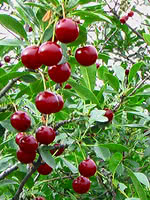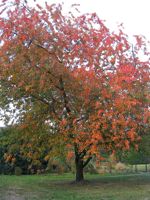Mon-Fri 9am - 5pm Mountain time
Juliet Cherry vs Black Cherry
Prunus x kerrasis Juliet
Prunus serotina
NOT AVAILABLE THIS SEASON - MIGHT RETURN
Juliet Cherry is a cold-hardy dwarf sour cherry. The deep burgundy fruit are known for being sweeter than other varieties, often considered one of the sweetest dwarf sour cherries. They are well suited to fresh eating, baking, and preserves. In the spring, beautiful white flowers cover the branches, adding ornamental value.
Juliet Cherry was developed at the University of Saskatchewan. It is recommended to grow dwarf sour cherries as a shrub rather than a small tree. The shrub form tends to bear fruit earlier and is less susceptible to winterkill.
Sour cherries are self-fertile; however, planting with additional varieties for cross-pollination can increase yields.
Black Cherry is common in eastern North America but a rare find elsewhere. This tree is shade tolerant and is often found in old fields, forest openings, and along fencerows.
The fruit is edible and is commonly used to flavor rum and brandy. It is also edible and often eaten fresh or used in wine or jelly. Black Cherry trees typically begin producing fruit when they are 10 years of age.
Black Cherry wood is a rich reddish-brown color and is strong, making it valued in cabinetry and woodworking. It is often used in reclamation as well.
The leaves can poison livestock as they contain cyanide derivatives and precursors. However, many have noted that deer still seem to browse their trees with impunity and birds and other animals eat the fruit when available.
Juliet Cherry Quick Facts
Black Cherry Quick Facts
Toxicity: bark and wilted leaves toxic to livestock

